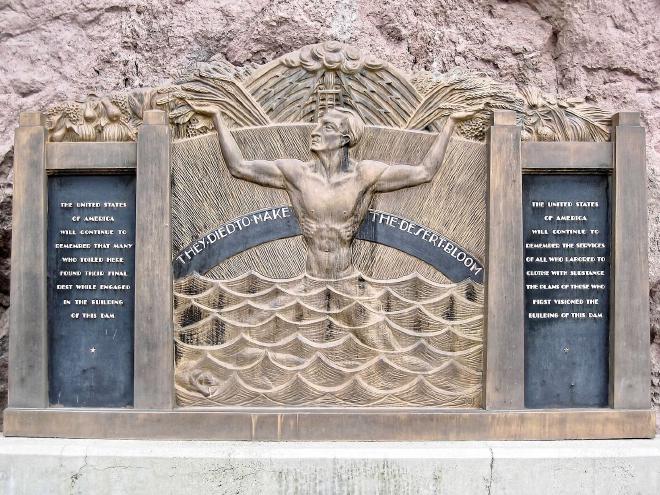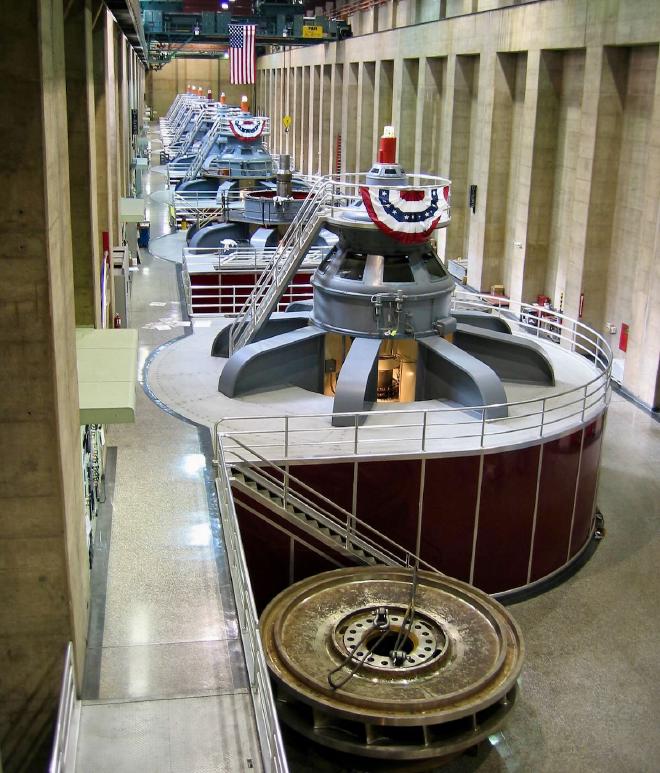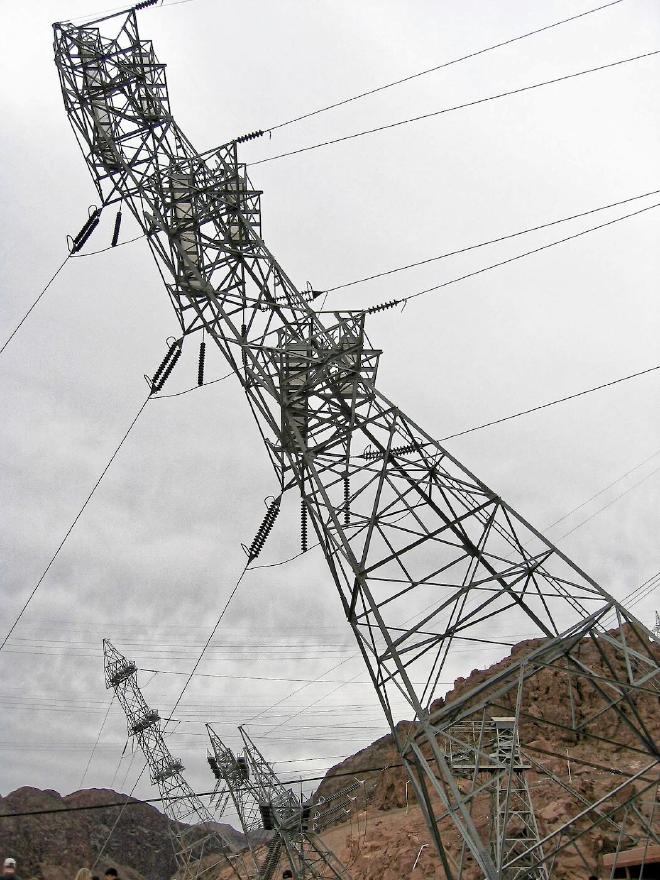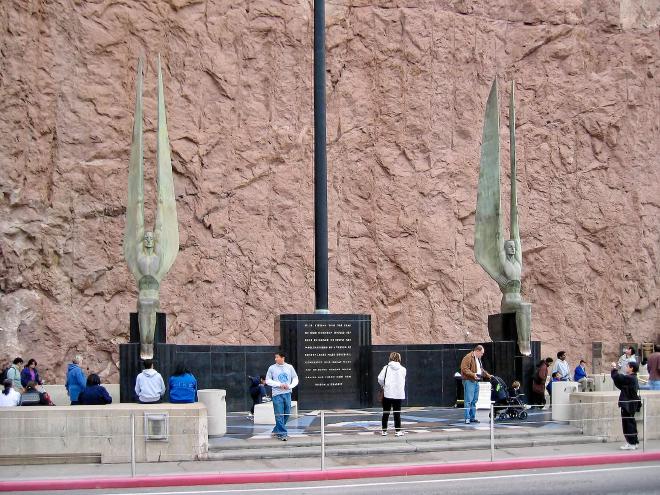Vegas Day 3: The Hoover Dam

I’d always wanted to see a dam, and as dams go, they don’t come much bigger than the Hoover Dam. Named after Herbert, rather than the more infamous J. Edgar, it’s possibly the most impressive piece of structural engineering of the 20th Century. Hoover gets the credit because as well as being a politician, he was a former engineer, and arranged the contracts between 7 different US states which would allow the project to go ahead.
We arrange a dam tour for under $20 apiece. The bus picks us up from the hotel, and transports us through sprawl and desert to the dam site. Once there we are given a couple of hours to do the official tour and wander around.
The dam itself is one of those objects that’s so big that you can’t perceive how big it is. It’s “won’t fit in a photograph” big, for starters — if you’re close enough to see detail, you’ll never find a wide angle lens wide enough; if you’re far enough away to get it all in the shot, it’ll just look like a small brick wall. Nevertheless, I tried to take a few photos of the outside which I could stitch together into a bigger image. On the left you can see the dam wall, with people and vehicles just about visible along the top. On the right you’re looking down at the turbine rooms 221 meters below; you can just about see a maintenance van parked down there.
Water enters the dam via the inlet towers, two in Nevada and two in Arizona. The dam itself is on the border between the two states, which follows the Colorado river.

The turbine rooms are pretty impressive, and much quieter than I expected. The foreground object is one of the turbine wheels. In spite of the dam’s massive scale, the power output is a modest 1430 MW, less than a quarter of that output by the Grand Coulee Dam in Washington State.

The generated electricity ends up inconveniently at the bottom of a gorge, and has to be transported back up the hillsides. Unfortunately, the local rock is rich in iron ore, so cables can’t be run through or across it. Hence the walls of the canyon are clustered with strange angular pylons which lean over and carry the cables through the air to the generators.

The dam took three years to construct, and was built under budget. To achieve that, men worked in horrendously unsafe conditions, braving 60 degree temperatures in summer, working in tunnels filled with clouds of carbon monoxide, and rappelling the canyon walls to spend entire days working dangling from the end of a single rope tether. Though the official death toll was somewhere between 96 and 112, they only counted people who died on site; anyone whose death was slow enough that they could be moved to a hospital first got excluded from the statistics. Memorials on site commemorate the deceased.
The dam as a whole is beautifully decorated in art deco style. The marble floors inside the buildings have iconic circular murals based on Native American symbols meaning “power” or “energy”. Even the public lavatories (men in Nevada, women in Arizona) have polished brass doors and inscriptions. Finally, two winged figures sit above Oskar Hansen’s star map, which provides astronomical measurements that should enable any future civilization or extraterrestrial archaeological dig to date when the dam was constructed.

One final detail is off to the sides of the dam: the spillway tunnels, two emergency flood control channels. In the event that Lake Mead begins to rise to a dangerous level, the excess water can be drained through these massive pipes. The spillway doesn’t look like much in the photograph, but it’s vaguely menacing in person — after all, it’s big enough that you could shove a Boeing 747 down it if you snapped the wings off, and there’s a delightful 200m drop once you get inside. In water flow terms, each spillway could easily carry the entire flow of Niagara Falls, or 5.6 million liters of water per second, traveling at 190 km/h at the bottom!

Of course, dams are controversial things. Some view them as ecologically damaging. Yet in the case of the Hoover Dam, it’s not so clear. Initial attempts to irrigate southern California had led to widespread flooding, and the accidental creation of a vast inland lake now known as the Salton Sea. The Colorado River began cutting through the California desert at over a kilometer a day, and threatened to form a new giant canyon. The system of dams now in place make the river controllable, and have stopped the massive erosion — yet at the same time, the dams mean that the Salton Sea has turned into an ecological disaster area.
Returning from the dam to Las Vegas, we get a chance to see the city in all its glory. It’s really quite amazing, mile after mile of urban sprawl in the middle of a desert, with mountains or tall hills on all sides. Construction seems to be pretty much continuous; if legalized gambling in other states has hurt Nevada’s economy, it doesn’t seem to show.
The bus drops us off at the Hilton, which was Elvis’s home-from-home up until his death. We head for the hotel diner and have an Elvis-style meal, as we hadn’t had time for lunch. I decide on a tuna melt, which turns up in fried white bread with fried onion rings. We eat at the counter. It’s possible to play KENO at the counter too; illuminated boards behind us animate the results of each game. KENO is basically like the lottery, except it has more options for what you can bet on, and you can lose every couple of minutes instead of only once a week.
Next we head for “Star Trek: The Experience”, our real reason for visiting the Hilton. It’s really expensive, but if you’re a Star Trek fan (or the spouse of a Star Trek fan) it’s just one of those things you have to do.
The first section is a kind of Star Trek museum, a complete Trek timeline from the present day onwards. Every few meters there are glass cases with artifacts from the appropriate shows or movies — a model of the Phoenix, a type II phaser, the Nomad space probe, and so on. As sara puts it, “This is the geekiest thing I have ever seen.”
After that you find yourself herded into the “experience”. I won’t say anything about it, because I don’t want to spoil the surprises, but I will say that if I have any complaint to make it’s that it all happened so rapidly… still, the admission fee lets you go around as often as you want, or until you give yourself a neck injury.
The gift shop is a big disappointment. I’ve always wanted a TNG-era science tricorder, but there’s nothing that cool or tasteful. The best toys are the burbling tribbles, and I resist the temptation — after all, it wouldn’t make sense to just have one. You can also stop at Quark’s Bar to have something to eat or drink. We’re still full of grease, so we take look around and leave.
It’s dark outside as we walk to the Stratosphere Casino and Hotel. It’s the tallest building in Las Vegas, and at 350m it’s close to the height of the Empire State Building.
As sara waits, I queue and get tickets so we can go up to the observation deck. From there we are treated to a marvelous view of the entire strip. If you follow the trail of bright lights, you can make out all the big casino hotels. The green one that looks as if it’s at the end is the MGM Grand; Mandalay Bay is just to the right of it in this photo.

For those who enjoy gut-wrenching terror, there’s a rollercoaster on the top of the Stratosphere which lets you get thrown around above a 300m drop, and a new ride called the “X-Scream” which dangles the rollercoaster car over the edge of the track as if there’s been some kind of horrible engineering failure. Personally, I have no real fear of heights, but I also have no real desire to develop one, so we give the rides a miss.
Back down at ground level in the casino, I had noticed a set of SPAM slot machines! We decide I have to sneak a photo of sara playing the SPAM machine, so we can send it back to her relatives near Austin, Minnesota, home of the SPAM factory. Hopefully hilarity will ensue.